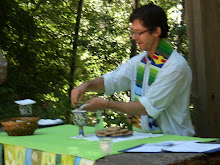This article appeared in two parts in the August and September 2013 editions of the newsletter of St. John's Episcopal Church, Petaluma.
It seems like every time I come to work nowadays something new
has been done to improve the accessibility, durability, efficiency, safety, or
beauty of the physical property of St. John’s.
These improvements are material signs of the renewal of the congregation,
and of our sincere commitment to making the presence of God known in Petaluma
in a positive and generous way. We feel
that God blesses this commitment, and our caring for the buildings and grounds
of the parish is not merely a duty of gratitude for the inheritance of faith
that they represent. It also needs to be
said that the foundation of all this work is the hope and confidence that God’s
mission for St. John’s Episcopal Church in Petaluma has a future.
Our historic church building is a constant reminder that our
present congregation is the continuation of a project that began on July 31,
1856, before Petaluma was even incorporated.
That small group of men and women that gathered with Bishop Kip to
establish St. John’s no doubt saw themselves as pioneers, and their eyes were
on the future, the future of the church they were founding and also the future
of the little village where they had come to settle. At the same time, they began with the memory
of Episcopal churches in places they had come from, where they had been formed
in a particular way of worship and life that they hoped to re-create in their
new setting. There
was something about that Anglican/Episcopal way they wanted to perpetuate
because they thought it was necessary for their future, and the future of California.
I like to tell people that the current congregation of St.
John’s is a church start-up in a 120-year old building. The paradox implicit in that description is
just one indication of the fact that our task is more complex than theirs was. It requires a pioneering spirit of a
different kind. The wide variety of backgrounds
and religious identities that our renewing congregation includes means that
there is no simple common denominator that defines our relationship to the past
of the parish, or the Episcopal Church tradition. And at the same time, I think we all share some
sense that this tradition, as a body nourished by the proclamation of the
Gospel and the mysteries of Christ, is at the heart of who we are as a community. The urge to preserve that essential core, to
receive its life-giving power, and to apply it vitally and faithfully to the challenge
of making the future, has, I think, been central to the mission of St. John’s
throughout its history.
At times in the past, this congregation has perceived a
threat in secular modernity and its vision of the common future. Defensively, it has turned to the
fundamentalist option. And, on at least two occasions, when the wider
Episcopal Church has responded positively, rather than reactively, to the
questions that modern culture posed to tradition, majorities of the people of
St. John’s have chosen schism. But what
if we were to see these self-inflicted wounds not as anomalies of someone
else’s history, but instructive chapters in a story that is ours to keep?
What if those schisms were tragic consequences, not of the
insistence on preserving tradition, but of failure to see the real power and
richness of the tradition that we claim?
What if the Christian tradition,
as collective memory, integrative wisdom, and transforming love, were not just
something venerable from the past, but a creative adaptation to the
future? What if enculturation of the
Gospel in the heavy adobe soil of the Petaluma valley were the still-unfinished
mission of this congregation?

No comments:
Post a Comment